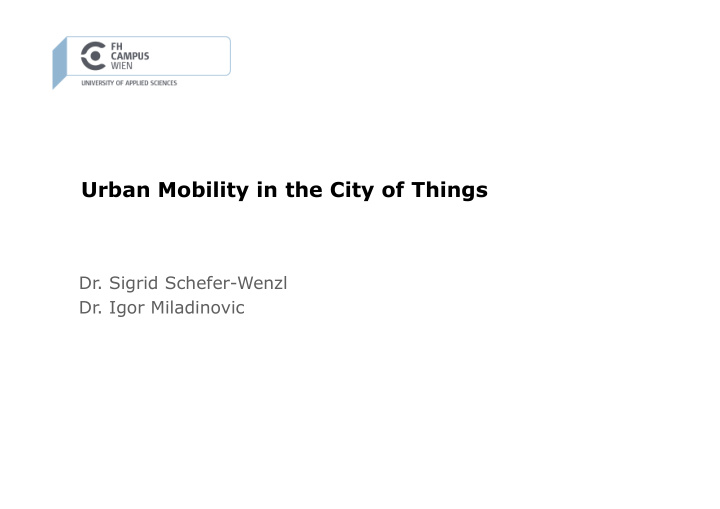



Urban Mobility in the City of Things Dr. Sigrid Schefer-Wenzl Dr. Igor Miladinovic
Agenda Introduction Problem statement Open Internet of Things (IoT) Architecture Cloud, Fog and Edge Computing for Smart Cities The Role of 5G Dynamic Application Allocation Example Use Cases Conclusions
Introduction Predictions of the number of IoT devices – multiple tens of billions connected devices by 2020 This generates new challenges, including: Scalability • Creation of a new, • converged access architecture Security • Maintainability •
Problem Statement Suboptimal administration of public resources and services in the majority of cities today: Lack of transparency – between different urban • administrations Data from various sources, such as sensors, cameras or • vehicles Smart cities IoT concepts improve the quality of public administration by: Continuous measurements of city data • Adapting behaviour of people and things accordingly •
Open IoT Architecture Precondition for a smart city enabling all public services to use a common infrastructure exchanging data for cross-optimization We propose a smart city IoT architecture with four layers: Street layer • City layer • Data center layer • Applications layer •
Proposed IoT Architecture
Smart City Applications Allocation Cloud Centralized • High scalability and capacity • Higher latency and network traffic • Fog Near the IoT devices • Lower scalability and capacity • Low latency and network traffic • Edge More complex IoT devices with some computation power • Lowest latency •
The Role of 5G Networks 5G focusses on several major requirements, highly relevant for IoT Our architecture supports 5G and benefits from Mobile- Edge Computing (MEC) MEC emerging technology for 5G networks – cloud computing within the Radio Access Network (RAN), comparable with fog computing We focus on a smart city IoT architecture with 5G and discuss the differences between cloud computing and MEC
Dynamic Applications Allocation Selected application parameters permanently measured Priority • Storage requirements • Network traffic between sensors/actors and the application • Optimal application allocation based on the measured data Applications with high priority are allocated in MEC to meet • time critical requirements Applications with medium and low priority can be • dynamically moved between the cloud and MEC
Example Use Cases Smart parking and smart lighting have both priority medium Smart parking is used more frequently in the day time Smart lighting is used more frequently in the night time L-Low, M-Medium, H-High
Conclusions Expected explosion of the number of IoT devices in the next years Public resources and services in the majority of cities today on a suboptimal level Introduction of an innovative IoT layered architecture for optimal management of applications allocation Two use cases demonstrate the anticipated benefits of the proposed architecture
Recommend
More recommend